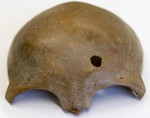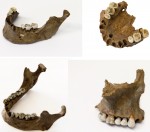 Archaeologists from the Vrije Universiteit Amsterdam (VU) have discovered what they believe to be the site of a bloody battle fought by Julius Caesar against the Tencteri and Usipetes tribes in 55 B.C. The site is at the confluence of the Maas (Meuse) and Waal rivers about 75 miles inland near modern-day Kessel, in the southern Netherlands province of Brabant. It’s the earliest known battlefield discovered in the Netherlands.
Archaeologists from the Vrije Universiteit Amsterdam (VU) have discovered what they believe to be the site of a bloody battle fought by Julius Caesar against the Tencteri and Usipetes tribes in 55 B.C. The site is at the confluence of the Maas (Meuse) and Waal rivers about 75 miles inland near modern-day Kessel, in the southern Netherlands province of Brabant. It’s the earliest known battlefield discovered in the Netherlands.
 Archaeological remains are rich in the area, unearthed for decades by amateurs and now collected at Amsterdam’s Allard Pierson Museum. The discoveries strongly suggested a significant violent event took place there in antiquity. Between 1975 and 1995 many late Iron Age weapons and artifacts were found there during dredging operations on the Kessel side of the Waal — 20 iron swords, spearheads, a cavalry helmet of Gallic origin that is the oldest ever found in the Netherlands, Germanic belt buckles, cloak brooches — as well bones from more than 100 individuals. The weapons and artifacts stylistically date the 1st century B.C., but only recently has radiocarbon analysis of the skeletal remains confirmed they date to the same Late Iron Age period. Osteological analysis of the bones show clear and copious sings of cutting injuries caused by swords and penetrating wounds caused by spears.
Archaeological remains are rich in the area, unearthed for decades by amateurs and now collected at Amsterdam’s Allard Pierson Museum. The discoveries strongly suggested a significant violent event took place there in antiquity. Between 1975 and 1995 many late Iron Age weapons and artifacts were found there during dredging operations on the Kessel side of the Waal — 20 iron swords, spearheads, a cavalry helmet of Gallic origin that is the oldest ever found in the Netherlands, Germanic belt buckles, cloak brooches — as well bones from more than 100 individuals. The weapons and artifacts stylistically date the 1st century B.C., but only recently has radiocarbon analysis of the skeletal remains confirmed they date to the same Late Iron Age period. Osteological analysis of the bones show clear and copious sings of cutting injuries caused by swords and penetrating wounds caused by spears.
 Stable isotope analysis of the tooth enamel from three individuals unearthed at the site confirm that they were not native the Meuse-Waal area but came from elsewhere. The Tencteri and Usipetes weren’t locals; they were Germanic tribes on the move, pressured by the Suevi people encroaching on their home territories to cross the Rhine and migrate west. The isotope analysis is ongoing and additional tests should reveal with more precision where they spent their childhoods.
Stable isotope analysis of the tooth enamel from three individuals unearthed at the site confirm that they were not native the Meuse-Waal area but came from elsewhere. The Tencteri and Usipetes weren’t locals; they were Germanic tribes on the move, pressured by the Suevi people encroaching on their home territories to cross the Rhine and migrate west. The isotope analysis is ongoing and additional tests should reveal with more precision where they spent their childhoods.
 The Kessel skeletal remains are mainly of men, but there are also women and children among them, all of whom died at the same time in what archaeologists believe was a single violent event rather than a series of events when the dead were buried in the same place. It seems there was a battle followed by a massacre after which the bodies of the dead were thrown in the Maas riverbed, as were their weapons. Some of the swords were found to have been deliberately folded or bent, a common ritual practice symbolizing the destruction of the object before burial.
The Kessel skeletal remains are mainly of men, but there are also women and children among them, all of whom died at the same time in what archaeologists believe was a single violent event rather than a series of events when the dead were buried in the same place. It seems there was a battle followed by a massacre after which the bodies of the dead were thrown in the Maas riverbed, as were their weapons. Some of the swords were found to have been deliberately folded or bent, a common ritual practice symbolizing the destruction of the object before burial.
Caesar wrote about a battle that fits this bill in Book IV De Bello Gallico.
The following winter (this was the year in which Cn. Pompey and M. Crassus were consuls [55 B.C.]), those Germans [called] the Usipetes, and likewise the Tenchtheri, with a great number of men, crossed the Rhine, not far from the place at which that river discharges itself into the sea. The motive for crossing [that river] was, that having been for several years harassed by the Suevi, they were constantly engaged in war, and hindered from the pursuits of agriculture.
The Usipetes and Tencteri in turn drove the Belgic Menapii tribe from their homes by tricking them into thicking they were leaving only to double back and catch the Menapii unawares. The Germanic tribes killed the Menapii, seized their ships and used them to cross the Rhine (possibly the Waal which is a distributary of the Rhine) where they wintered comfortably on Menapii supplies.
Caesar heard of this and became concerned that the movement west of the Usipetes and Tencteri would get the Gauls all het up. Indeed, his scouts discovered that Gallic peoples were already beginning to deal with the Germans, appeasing them with money and valuables and drawing them further into Gaul itself. The Usipetes and Tencteri attempted to negotiate with Caesar, offering their fighting skills in exchange for being allowed to keep the lands they’d just taken, for new lands or for support against the Suevi who were driving them from their homeland.
Caesar wasn’t keen but agreed to a temporary truce while they worked out a possible resettlement option. The Germans panicked at the sight of Roman cavalry and attacked anyway. Caesar, now considering the truce ended by their treachery, put his game face on.
Having marshalled his army in three lines, and in a short time performed a march of eight miles, he arrived at the camp of the enemy before the Germans could perceive what was going on; who being suddenly alarmed by all the circumstances, both by the speediness of our arrival and the absence of their own officers, as time was afforded neither for concerting measures nor for seizing their arms, are perplexed as to whether it would be better to lead out their forces against the enemy, or to defend their camp, or seek their safety by flight. Their consternation being made apparent by their noise and tumult, our soldiers, excited by the treachery of the preceding day, rushed into the camp: such of them as could readily get their arms, for a short time withstood our men, and gave battle among their carts and baggage wagons; but the rest of the people, [consisting] of boys and women (for they had left their country and crossed the Rhine with all their families) began to fly in all directions; in pursuit of whom Caesar sent the cavalry.
The Germans when, upon hearing a noise behind them, [they looked and] saw that their families were being slain, throwing away their arms and abandoning their standards, fled out of the camp, and when they had arrived at the confluence of the Meuse and the Rhine, the survivors despairing of further escape, as a great number of their countrymen had been killed, threw themselves into the river and there perished, overcome by fear, fatigue, and the violence of the stream. Our soldiers, after the alarm of so great a war, for the number of the enemy amounted to 430,000, returned to their camp, all safe to a man, very few being even wounded.
Caesar’s numbers are exaggerated. Archaeologists believe the real number of Tencteri and Usipetes was somewhere between 150,000 and 200,000 and he couldn’t have killed them all. Plutarch says that there were survivors who were taken in by the German Sugambri tribe, much to Caesar’s irritation.
So, is the Kessel battlefield the one Caesar describes in De Bello Gallico? The evidence of a battle having taken place there between Gauls or Romans and Germans in the 1st century B.C. is strong. Whether it’s the specific battle described by Caesar, that’s more challenging to determine. I think they’re relying a little heavily on the presence of slaughtered civilians matching Caesar’s description of the battle’s aftermath. It seems to me you’d need coins, legion references or maybe remains of the camps to narrow down the time and combatants more precisely before you can comfortably claim, as the VU press materials do, that this is the “first time that the presence of Caesar and his troops on Dutch soil has been explicitly shown.”
The finds are currently on display in the Allard Pierson Museum and will be exhibited at least through next month.